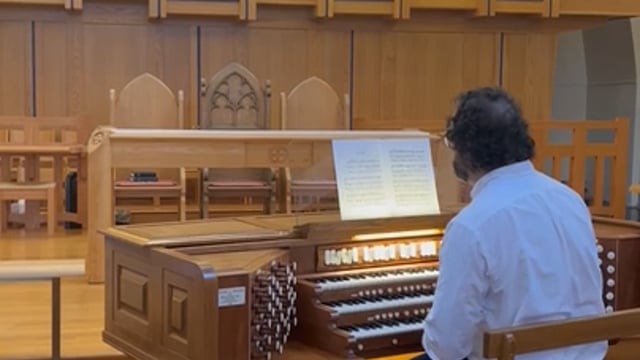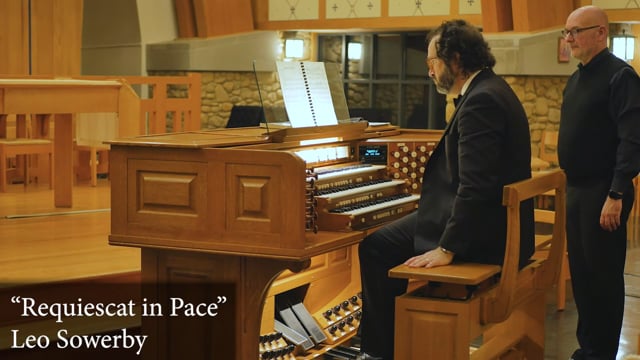Patrick J. Murphy & Associates Organbuilders, Stowe, Pennsylvania; Saint John’s Episcopal Church, Johnson City, Tennessee

From the builder
As is often stated by the Organ Clearing House, with the closing of many churches, pipe organs become available for purchase and relocation. Such is the situation that befell M. P. Möller Opus 7435R.
But first, a little background. M. P. Möller Opus 7435 was built for the First Presbyterian Church in Reading, Pennsylvania, in 1946. Installed in divided chambers located high within the chancel, the organ contained three manuals and approximately 22 stops. In 1965 the instrument was rebuilt and enlarged by Möller to 25 stops. The rebuilding was typical for the time, along with refreshment of the windchest actions, a Scharf and extensive Bombarde unit (32′, 16′, 8′, 4′) were added.
By 2004 the instrument was once again showing signs of mechanical wear and tear as well as a need for tonal rebalancing. Patrick J. Murphy & Associates, located in Stowe, Pennsylvania (just ten miles away), was engaged to perform a comprehensive overhaul (to become our Opus 47) that included new electric slider windchests, new winding, additional foundational flues and reeds, as well as comprehensive revoicing. The majority of the Great was relocated outside of the cramped chambers to allow greater tonal development within the acoustically challenged space. Digital 32′ stops and percussions from Walker Technical Company were added as well as one of our very first signature low-profile drawknob consoles.
Unfortunately, no sooner had the instrument been dedicated than the First Presbyterian Church had a schism that resulted in several key leadership persons departing, including the organist and organ financial donor. The position of organist remained mostly vacant, filled primarily by a string of supply musicians, except for the last person to hold the post. Finally, after facing mounting debt and declining membership, the downtown building was sold in 2018, and the congregation relocated to a dramatically smaller facility outside of the city, leaving the building and most of its contents behind, including the organ. A new owner for the organ was sought.
In January of 2021 Patrick J. Murphy & Associates purchased, removed, and stored the organ at its own expense until a suitable new owner could be located. As is often the case, locating a similar situation that supplied chambers limited the number of opportunities to find a home.
Fortunately, in the spring of 2021, Nick Andrews, director of music at Saint John’s Episcopal Church in Johnson City, Tennessee, who had learned of our work through word of mouth, inquired with us about either a new or rebuilt instrument. While my first visit to Johnson City was to discuss a new free-standing instrument that “might” utilize material from the existing 1960s Möller already installed second hand, the distinguished architecture of the room provided me with a vision of incorporating our Opus 47 into a new, free-standing instrument. Early on we engaged the superlative talents of Frank Friemel to produce an inspired design and rendering, after which he informed us that this was to be his swan song. Our staff performed all the remaining design and construction work except for the all-new case, which was entrusted to R. A. Colby Inc., located just 1.8 miles (and one turn) away from the church. Construction began in the fall of 2022, and installation started in the spring of 2023.
The new installation, now Opus 47R, incorporates our 2004 updates of new slider windchests, console, and pipework additions along with most of the pipes retained from Möller Opus 7435R, with all pipework regulated for the new space. The thoroughly revised interior layout sits atop all new and quite substantial framing and is supplied by a new winding system. This new structure is capped by our all-new two-inch-thick expression enclosures and shades. The façade pipes are a combination of formerly interior Moller 16′ Diapason pipes and façade pipes added in 2004, all professionally modified and painted by Organ Supply Industries to an exceptional result.
The pipe voicing, unfortunately partially entombed in its former location in Reading, came into full blossom within this acoustically friendly space. My first service hearing the instrument under Nick’s superlative playing gave me the closure of feeling like this could have been where this instrument was meant to be all along.
We wish to thank director of music Nick Andrews for his easy, straightforward manner and support, and also all the leadership members and congregation of Saint John’s for their support and for the opportunity to provide Opus 47R with a good home. We also wish to thank Frank Friemel, the staff at R. A. Colby, and Organ Supply Industries for their excellent work. And finally, I wish to thank everyone on my staff who worked tirelessly and diligently on this installation.
—Patrick J. Murphy
From the director of music
Saint John’s Episcopal Church is located in scenic Northeast Tennessee in the heart of downtown Johnson City. Known locally as “The Rock Church,” the original building was constructed of native river rock from the Nolichucky River in 1905. For many decades leading up to the late 1990s, the seating capacity of the 1905 nave restricted the rapidly growing parish, resulting in the use of overflow seating in the narthex of the church for multiple services on Sunday morning. In 2000, the congregation broke ground for a new nave with a seating capacity of up to 400 people. The new nave was completed and consecrated in November of 2001. Like the original 1905 structure, river rock was also incorporated into the new building. Designed by Memphis, Tennessee architect Jim Williamson, the nave is featured in the book Architecture for the Gods (Book II) by Michael Crosbie.
A 1960 Möller of 28 ranks was relocated to Saint John’s from an Episcopal church in a suburb of St. Louis, Missouri, in the fall of 2001 and was completed in early 2002. For the next twenty years, the aging Möller suffered ongoing mechanical and tonal issues. In January 2020, two years after I was hired as director of music, the organ mechanically failed from ciphers and wind leaks and was unusable for services. After submitting a written report to the church vestry, an organ committee was formed to investigate our next steps for the instrument. After initially meeting with several builders, the covid pandemic halted the progress of the organ committee until January 2021. In early 2021, I contacted Patrick Murphy to see if he would be willing to assess our instrument and make a proposal. While visiting onsite, I inquired about his Opus 47 (formerly of First Presbyterian Church, Reading, Pennsylvania, which had been listed on the Organ Clearing House website for some time) as a candidate for relocation. After examining the measurements of the room, it was deemed that Opus 47 would indeed fit within the footprint of the former instrument.
After a trip in May of 2021 to listen to and play several fantastic instruments of Patrick’s in Baltimore, Maryland, I made a recommendation to the organ committee to pursue the proposal for relocating Opus 47 to Saint John’s. In December of 2021, the vestry of the church voted to accept the proposal from Murphy and signed the contract. The installation for Opus 47-R began in June of 2023 and was completed a few months later in early September. The new casework has transformed the room, and it truly looks like it was always meant to be there! The instrument is full of rich 8′ tone on each division and houses a plethora of 16′ tone in the pedal division—as every instrument should! I am grateful to the entire team at Patrick J. Murphy & Associates who helped rebirth this amazing instrument! Opus 47-R has a very bright future for many decades to come!
—Nick Andrews
Director of Music
Builder’s website: www.pjmorgans.com
Church’s website: stjohnstn.org/
Photo credits: Patrick J. Murphy
GREAT (manual II)
16′ Lieblich Gedackt (Swell)
16′ Gemshorn (ext) 12 pipes
8′ Principal 61 pipes
8′ Harmonic Flute (1966) 61 pipes
8′ Gemshorn 61 pipes
8′ Bourdon* 61 pipes
4′ Octave 61 pipes
4′ Flute 61 pipes
2-2⁄3′ Twelfth (1966) 61 pipes
2′ Super Octave 61 pipes
1-1⁄3′ Mixture IV (encl w/Choir)* 244 pipes
8′ Trumpet (encl w/Choir)* 61 pipes
8′ Tromba (prepared for)
8′ Trumpet (Swell)
Great 16
Swell to Great 16-8-4
Choir to Great 16-8-4
Chimes (digital – 37 notes)
Great MIDI
Great/Choir Transfer
SWELL (manual III, enclosed)
16′ Lieblich Gedackt (ext) 12 pipes
8′ Diapason* 61 pipes
8′ Gedackt 61 pipes
8′ Viole 61 pipes
8′ Viole Celeste (TC) 49 pipes
4′ Principal 61 pipes
4′ Harmonic Flute 61 pipes
2′ Flautino 61 pipes
2′ Plein Jeu III–IV* 232 pipes
16′ Contra Trumpet (ext)* 12 pipes
8′ Trumpet* 61 pipes
8′ Oboe* 61 pipes
8′ Vox Humana (2023) 61 pipes
Tremulant
Swell-16-UO-4
Swell MIDI
CHOIR (manual I, enclosed)
8′ Geigen (1966) 61 pipes
8′ Viola 61 pipes
8′ Concert Flute 61 pipes
8′ Dulciana 61 pipes
8′ Unda Maris (TC) 49 pipes
4′ Fugara 61 pipes
4′ Nachthorn 61 pipes
2-2⁄3′ Nazard* 61 pipes
2′ Blockflute* 61 pipes
1-3⁄5′ Tierce* 61 pipes
1′ Scharff III (1966) 183 pipes
8′ Clarinet 61 pipes
Tremulant
8′ Trumpet (Great)
8′ Tromba (prepared for)
Choir to Choir 16-UO-4
Swell to Choir 16-8-4
Harp (digital)
Celesta (digital)
Choir MIDI
PEDAL
32′ Double Open Diapason (digital)
32′ Contra Bourdon (digital)
16′ Open Diapason (digital)
16′ Principal (1946/2023) 56 pipes
16′ Gemshorn (Great)
16′ Violone (digital)
16′ Bourdon 44 pipes
16′ Lieblich Gedackt (Swell)
8′ Octave (ext)
8′ Bourdon (ext)
8′ Gedackt (Swell)
4′ Choralbass (ext)
III Mixture* 96 pipes
32′ Contra Trombone (digital, w/Choir)
16′ Trombone (ext, 2023) 12 pipes
16′ Contra Trumpet (Swell)
8′ Trumpet (Great)
4′ Clarion (Great)
Great to Pedal 8-4
Swell to Pedal 8-4
Choir to Pedal 8-4
46 ranks (47 when completed), 2,709 pipes
* = 2004







